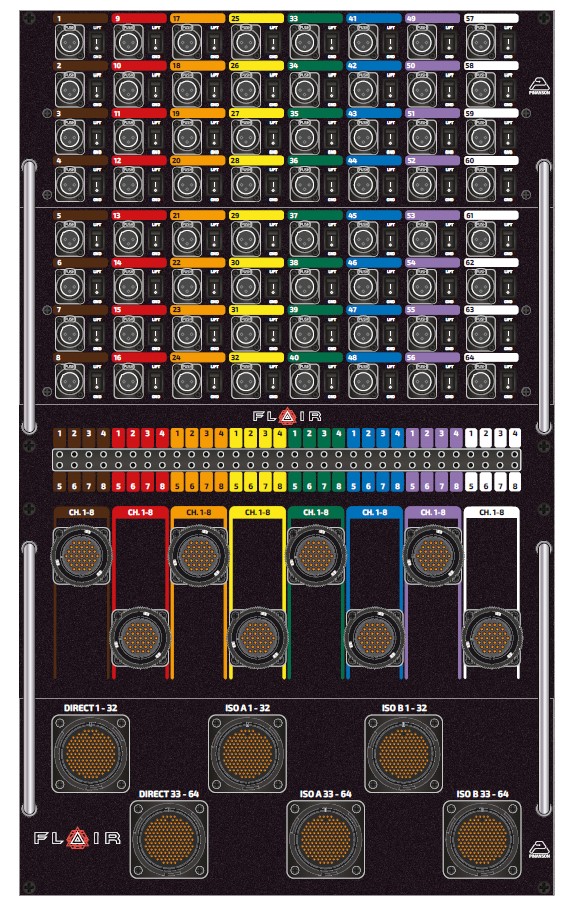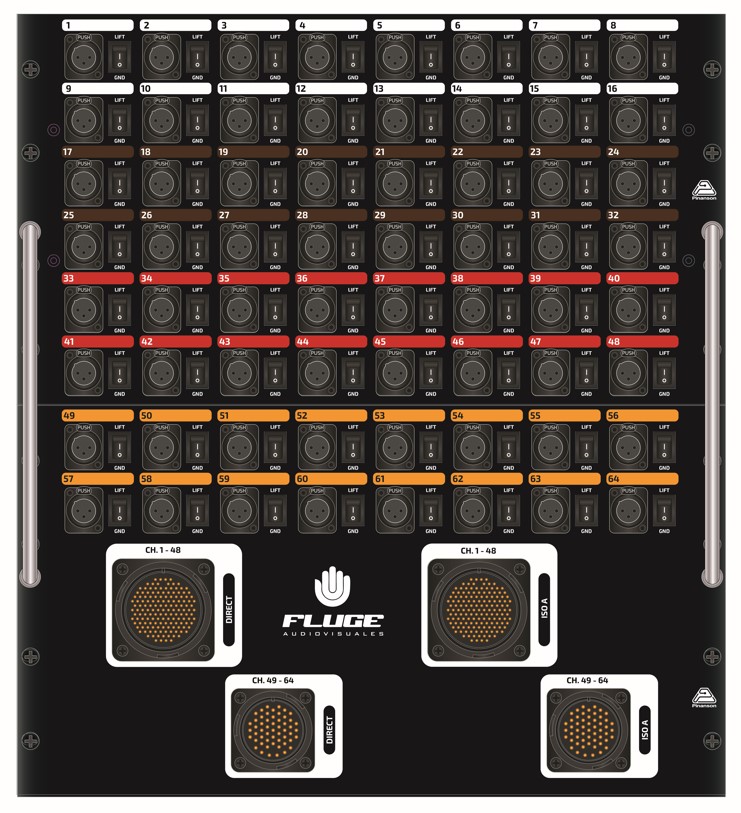I need an audio distributor…
You have to buy a microphone signal distributor for an auditorium. You need the 64 microphone signals on stage to be distributed to:
- An FOH console in the auditorium (from where the +48V phantom signal will be fed to those microphones)
- A monitor console
- A recording console (external to the auditorium)
That is, you need those 64 microphones replicated in three different destinations.
For this, there are MIC/LINE audio distributors for the stage. Which consist of the following parts:
- Microphone input on XLR-H
- Direct output, in parallel with the input for microphone phantom power
- Isolated outputs and/or non-isolated outputs: distribution of outputs using a transformer or without a transformer in parallel with the input.
- Ground Lift, to have the possibility of lifting the ground in case of ground loop problems.
When audio distributors are custom made, the variety of examples designed for customers can be very wide.
Below you can see just a few examples:
When requesting a quote for a signal distribution equipment, clients are normally clear about its characteristics in terms of functionality: the number of channels they handle at their events, how many consoles they are going to take the signals to, if they want patching, remote boxes, the order of the signals, colors to classify them, the format of the equipment (if they want it portable or to be racked…).
But there is a general doubt when you ask them if they want to isolate the outputs by transformer or not.
What do I have to know to order equipment with transformers or another that does not have them?
(1) That parallel audio distribution is not always possible
That is, connect several devices using Y cables.
This is because it is not possible to make an infinite number of connections in parallel. The maximum number of times the signal can be split will be determined by the output impedance of the audio source (for example, a microphone) and the input impedance of the receiver (for example, a mixing console).
For maximum voltage transfer and to avoid degradation of the audio signal (level loss, low frequency loss, increased distortion) the total input impedance of the receivers must be at least 10 times greater than the output impedance of the source.
Zin total > 10·Zout
And, with a transformer?
If this signal distribution is carried out using transformers with a ratio of 1: 1 + 1, from one input to two outputs, or 1: 1 + 1 + 1, from one input to 3 outputs, the impedance ratio is maintained, that is, The input impedances of the receiving equipment would not be in parallel with each other.
(2) That we must prevent possible problems with some connections from affecting the others.
If one of the receivers (in our example, mixing console) has a short circuit, this will affect the rest of the outputs since they are in parallel with each other.
And, with a transformer?
If transformers are used, there is galvanic isolation between some outputs and others, so a short circuit, or other problem in the cable or receiver, will not affect the adjacent outputs.
(3) Noise caused by ground loops must be avoided
Ground loops cause noise (hum, buzz in English terms, low and high frequency noise).
When several devices are connected to the distributor outputs, the increased possibility of ground loop noise also increases.
If, in addition, the equipment is from third parties (such as a mobile recording unit), we will not control the status of the equipment that will be connected to ours.
And, with a transformer?
Isolating the interactions between the different branches of the circuits greatly simplifies the search for noise problems. With transformers we isolate the signals and the grounds between some channels and others.
Trying to locate the reason for the noise and solve it in large audio systems can be very complicated, it is better to stay healthy and keep some equipment isolated from others.
So in summary, transformers when?
As a recommendation to avoid the problems we have talked about, these two rules can be followed:
(1) When it cannot be met that the total impedance of the receivers is 10 times greater than the source impedance.
For this we should remember that the total impedance of n impedances in parallel is:
Formula to calculate the total impedance of equipment connected in parallel. Click on the formula to access the DigiKey impedance calculator
(2) When the condition of equipment that does not belong to us cannot be guaranteed.
When the equipment comes from other companies other than ours. And we want to avoid possible noise and signal loss problems.











